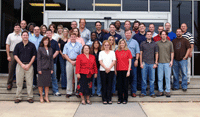Protecting the Army's most valuable assets'America's sons and daughters'means good warfighting training, and the use of effective equipment. But it also means reducing off-duty risk'when a soldier rides a motorcycle for pleasure, for instance, or takes a long trip on leave to a potentially hazardous destination.That's where the Combat Readiness Center comes in. A field-operated agency based at Fort Rucker, Ala., CRC's IT directorate, or G6, uses state-of-the-art information systems and online applications to deploy a range of programs that track situations that could result in possible accidents or deaths.Formerly known as the Army Safety Center, CRC continues to follow a simple but important philosophy'readiness through safety. Fewer accidents off-duty mean a better on-duty combat force, officials said.'When a soldier is hurt, even off-duty, he or she is taken out of the fight,' said Melissa Johnson, director of CRC's IT division. 'We want to drive the arrow of loss down, and reduce risk.'And the arrow is falling. As of Sept. 19, Army accident fatalities were down 20 percent compared with the same date in the last fiscal year, Johnson said.CRC's Risk Management Information System (RMIS) serves as an umbrella repository of knowledge for commanders, soldiers and employees, containing extensive accident data, lessons learned and Army safety messages.Knowledge from RMIS can be leveraged in various ways. The Army Safety Management Information Systems (ASMIS) 1 and 2, for example, aim to reduce accident occurrence in three areas'ground, aviation and driving.One particularly effective program has been the ASMIS-2 POV'privately owned vehicles'which targets those driving cars, motorcycles and trucks. After soldiers input their vehicle type and trip information, ASMIS-2 offers graphics, accident data, safety messages and other information that gives soldiers a heads-up about potential risks, including such matters as vehicle vulnerabilities or road problems.'It's about raising their awareness,' Johnson said.The program has a particular focus on motorcycles, which have been identified in the past as a high-risk endeavor, she added.So far, more than 1.3 million risk assessments have been conducted using ASMIS-2 POV. Of those, only five driver deaths have been reported.'If you compare this to the 46,000 people that died on America's highways last year'soldiers are clearly reducing risk by using ASMIS-2,' said Brig. Gen. Joseph Smith, the former director of safety for the Army, who also served as the commanding general of the CRC.The impressive results have attracted other services. The Navy recently adopted ASMIS-2 POV, and the Air Force plans to do the same within the next year.'It's a tool that's been adopted by other services because of the efficacy we've seen here,' Johnson said.In part, Johnson attributes the G6's impressive results to the successful use of flexible, easily modified online applications. New mandates, such as changes in safety requirements, can be easily incorporated into the Web sites for maximum currency. Most young soldiers are Web savvy, she said, so the applications are an effective way to reach a large number of users.[IMGCAP(2)]'We don't use cutting-edge technology just for the sake of using it,' Johnson said. 'We're looking for the biggest bang for our buck.'The G6's networking equipment'routers, switches and firewall'is from Cisco Systems Inc. of San Jose, Calif. Microsoft Corp.'s technology frequently is used, including Microsoft Operations Manager, Microsoft ASP.Net for building applications, and a Microsoft SQL Server 2000. CRC builds applications using Cold Fusion from Adobe Systems Inc. of San Jose, Calif. Databases include Oracle 10g, which resides on a RedHat Linux platform.'The CRC is a small organization serving a million-man force in over 120 countries. The only way to do this is to have great tools,' Smith said.Of course, even the best operations cannot prevent accidents entirely. CRC also handles accident reporting, which can be done via telephone or online. Besides initial notification of an accident, and the more extensive information reported afterward, CRC also has an anonymous reporting program called 'Close Calls,' which lets personnel report near accidents.Such 'Close Call' information can be used to identify hazards and spur corrective change. 'It's an important tool,' Johnson said.Other CRC resources include a wide variety of online courses. Staff members must continue to bring their programs to the attention of Army personnel, which is constantly rotating.'We've really engaged the leadership on this,' Johnson said. 'We know that we have to constantly reach out.'Many new projects dot CRC's near-term horizon. One is development of a predictive capability, through the use of advanced data-mining software, according to Kerry Brown, the deputy director of Army safety.Such a system would offer predictions of potential system or individual failure, and identify vulnerabilities previously unseen.'When fully operational, the analyses may produce profiles of at-risk units,' Brown said.Another project involves consolidating numerous independent safety and occupational health reporting systems into a single Army system that would save money, decreasing redundancy and letting employees collate and analyze information from different angles.'You could kind of look at it from a Rubik's cube perspective,' Johnson said.Meanwhile, demand continues to grow'Web site hits have grown to more than 14 million per month. And that clearly indicates that that CRC staff know how to design quality products, Smith said.'Want people to use your stuff?' Smith said. 'Focus on their needs, provide real value to their Web experience and unleash the talent of the digital warriors.'
It's a tool that's been adopted by other services because of the efficacy we've seen here.' Melissa Johnson, CRC IT director
Courtesy of the Army Combat Readiness Center
SAFETY FIRST: Melissa Johnson (front row, second from left) and her team at the Combat Readiness Center, based at Fort Rucker, Ala., developed online applications to promote good safety practices for personnel, particularly when they're off-duty.
Courtesy of the Army Combat Readiness Center








